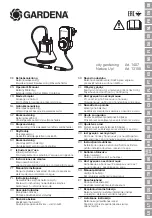
6.3 Remote control LC-3
The remote control LC-3 available as an accessory
allows to control various functions.
1) Connect the remote control to the jack ONLY FOR
REMOTE CONTROL (5).
2) There must be no DMX signal at the DMX INPUT (7).
3) Via the DMX OUTPUT (8), further LED-812DMX
units may be connected (
chapter 6.2) in order to
control them together with the master unit via the
remote control.
4) The button STAND BY (11) allows to activate/deac-
tivate the light beams. With the beams deactivated,
the LED next to the button STAND BY will light up
as a check.
5) Select the operating mode with the button MODE
(13).
a) When the LED of the button MODE is on, the
Chase mode
will be activated. By shortly press-
ing the button FUNCTION (12), the speed of
rotation can be selected in eight steps. Each
time the button is pressed, the sense of rotation
will change at the same time.
b) When the LED of the button MODE is off, the
Stroboscope mode
will be activated. By keep-
ing the button FUNCTION pressed, one of the
three stroboscope functions can be activated:
1. Permanent stroboscope
2. Stroboscope salvos
3. Music-dependent stroboscope
When the button FUNCTION is kept pressed
again, the next stroboscope function respec-
tively will be activated.
7
Operation via a Light Controller
For operation via a light controller with DMX512 proto-
col (e. g. DMX-1440 or DMX-510USB by “img Stage
Line”), the LED-812DMX is equipped with 3 DMX con-
trol channels. However, it will be also be possible to
control the LED-812DMX via only one channel if the
functions assigned to this channel are sufficient. The
functions of the channels and the DMX values can be
found in chapter 9.1.
7.1 Connection
As a DMX interface, the light effect unit is provided with
3-pole XLR jacks of the following pin configuration:
Pin 1 = ground, 2 = DMX-, 3 = DMX+
For connection, special cables for high data flow
should be used. Standard microphone cables with
screening and a minimum cross section of 2 ×
0.22 mm
2
and with a capacity as low as possible can
only be recommended for a total cable length of up to
100 m. For cable lengths exceeding 150 m it is recom-
mended to insert a DMX level matching amplifier (e. g.
SR-103DMX by “img Stage Line”).
1) Connect the DMX input (7) to the DMX output of the
light controller.
2) Connect the DMX output (8) to the DMX input of the
following light effect unit; connect its output again to
the input of the following unit, etc. until all light effect
units have been connected in a chain.
3) Terminate the DMX output of the last DMX unit in
the chain with a 120 Ω resistor (> 0.3 W): Solder the
resistor to the pins 2 and 3 of an XLR plug and con-
nect the plug to the DMX output or use a corre-
sponding terminating plug (e. g. DLT-123 by “img
Stage Line”).
7.2 Adjusting the start address
and the number of DMX channels
For operating the LED-812DMX with a light controller,
adjust the DMX start address for the first DMX channel.
If e. g. address 17 on the controller is provided for con-
trolling the function of the first DMX channel, adjust the
start address 17 on the LED-812DMX. The other func-
tions of the LED-812DMX will then automatically be
assigned to the following addresses. An example with
start address 17 can be found below:
Fig. 5 DMX address assignment when using start address 17
1) The start address is adjusted as a binary number
with the DIP switches Nos. 1 – 9 (2). It will result by
adding the place values of the switches set to “ON”.
Examples of the start addresses 1, 6 and 104:
Fig. 6 Start address 1: switch No. 1 set o ON
Fig. 7 Start address 6: switches Nos. 3 and 2 set to ON
Fig. 8 Start address 104: switches Nos. 7, 6 and 4 set to ON
The easiest way is to start from the highest possible
place value and to add the smaller values until the
start address will result.
1
4
2
8
16
32
64
128
256
OPTION
1
4
2
8
16
32
64
128
256
OPTION
←
Switch number
←
Place value
1
4
2
8
16
32
64
128
256
OPTION
Number of
DMX channels
DMX addresses
used
Next possible start address
for the following DMX unit
1
17
18
3
17 – 19
20
10
GB











































